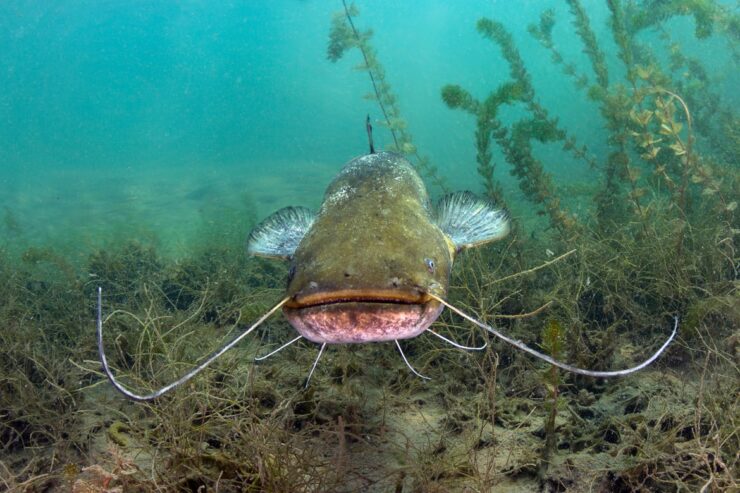All fishing is fun, but for some reason, catfishing seems to have a little more appeal to a lot of people. Perhaps it is the simplicity, or the slower pace, or that catfish are at the top of the list for table fare, especially in the South….who knows? Whatever the reason, catfish have a huge fanbase, to the point where many seldom fish for anything else.
Regardless of your station in life, you can fish for catfish.
They can be caught on just about any kind of rig, cane pole, and in many states, it is even legal to catch them with your bare hands with a technique called ‘Noodling’. You can use trotlines, which is simply a mainline run between two semi-submerged trees with 25 baited hooks. You just check the line every hour or so and remove any hooked catfish, and re-bait.
You can use juglines, which are just plastic jugs with a baited hook and line attached, and left to free float. When a catfish bites, you just chase the jug in a boat and pull it in. Most people use 5 or more at a time, and sometimes the action gets fast and furious when you have to chase several jugs at once.
You can catch catfish from a boat, kayak, canoe, paddleboard, wade, or just fish from shore. All you need is a cane pole, or medium rod and reel, a few ¼ oz slip sinkers, a couple of sz 1, or 1/0 bait hooks, or even Khale hooks, a few swivels, and maybe a float or two. For bait, just about anything works, including dead minnows, chicken livers, hot dogs, dog food, old shrimp, or prepared commercial baits with an odor that could knock out a buzzard. Catfish aren’t very picky about what they eat…the smellier, the better.
Table of Contents
ToggleAll Catfish Are Not Created Equal
Catfish belong to the family of bony fish called Siluriformes, which includes over 3000 recognized species in 36 families. It is almost certain that there are many species still not categorized. In general, they are all bottom or near bottom feeders, have no scales, and are very adaptable. Their adaptability has caused them to become major invasive species in some areas.
In sizes, they can range from less than 1 inch to over 7 feet long and weigh close to 1000 pounds. For fishing purposes in the United States, you need only be concerned with 4 species. In order of popularity, they are the Channel, Blue, Flathead (or Yellow), and Bullhead catfish.
1. Channel Catfish
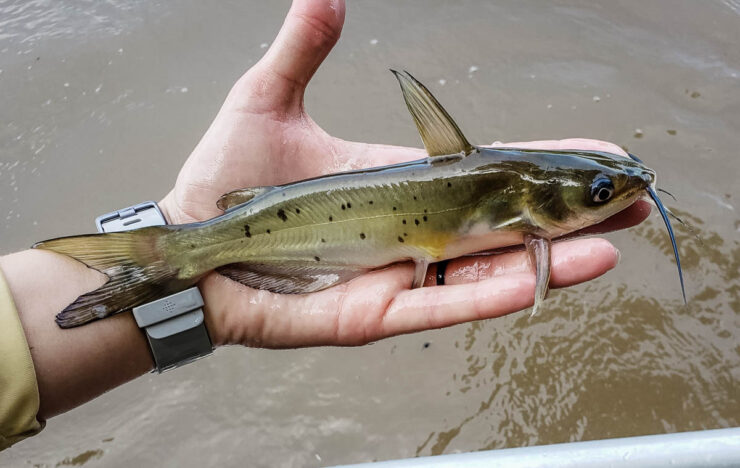
Channel Catfish (Ictalurus punctatus) are the most numerous species in N. America. They are the most popular species for fishing, with over 8 million anglers trying their luck annually. They are also the most important species commercially and are raised in Catfish Farms for food.
Channel Cats can be found just about everywhere in S. E. Canada, the U.S., all the way to Northern Mexico. They inhabit smaller rivers, large rivers, lakes, ponds, and reservoirs. They cruise near the bottom around structures such as weed beds, submerged timber, sunken cars, rock piles, along channel edges, behind spillways, docks, pilings, and any other structure.
They are active at night, making them the #1 fish for night fishing, and can be caught all year long, even through the ice.
They have taste sensors all along their body, making them a swimming tongue capable of detecting chemical concentrations as low as1 part per million from several hundred yards away, which is why odiferous baits work so well.
Channel Catfish average from 2-5 lbs, but 10-pounders are not uncommon. In larger bodies of water, 20-pounders are caught all the time. The world record is 58 pounds, so far. They will eat pretty much anything organic that gets in their way, including soap, hot dogs, dog food, WD-40, large insects like grasshoppers, frogs, mice, other fish, and dough baits that stink so bad that if you open them in the house, it will kill all the houseplants …even the plastic ones.
Channel Cats and their very close relative, the Blue Catfish are often confused with each other.
Blue Cats get much bigger, up to 100 pounds and more. It doesn’t help that their habitats overlap, a lot. They are very similar in appearance. The way to tell them apart is to look for small spots along the sides. Blue Cats have no spots. Another way is to count the rays on the anal fin. A Blue Cat has 30-36 rays, and Channel Cats only have 25-29.
2. Blue Catfish
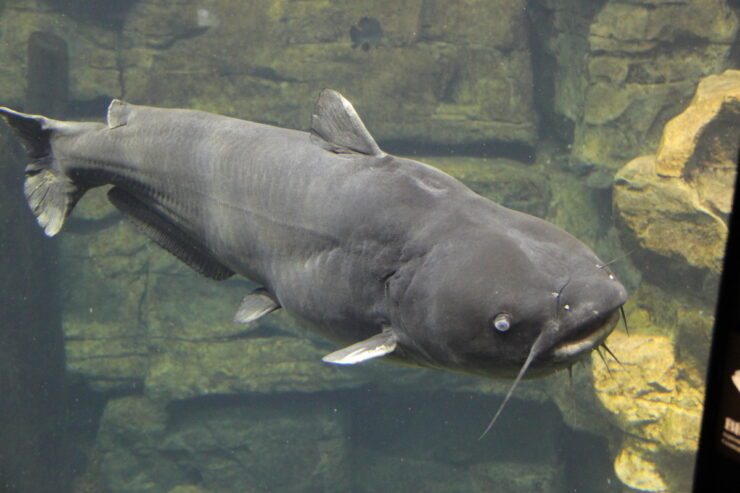
The Blue Catfish is the behemoth of the North American catfish world, reaching lengths of over 5 feet and over 150 pounds. Their average size is 10-20 pounds. 40-pounders are not uncommon. They closely resemble their relative, the Channel Catfish, and are often confused with them. The way to tell them apart is to look for small spots along the sides. Blue Cats have no spots.
And, as a rule, anything over 20 pounds is most likely a Blue Cat. You can also count the rays in the anal fin. Blue Cats have 30-36 rays, and Channel Cats only have 25-29.
Blue Catfish are native to the Mississippi River drainage, which includes the Tennessee, Cumberland, Rio Grande, Missouri., Arkasas, and Ohio Rivers. Their range has been expanded somewhat through stocking programs, but in many areas, they are considered an invasive species. They can tolerate brackish water better than other species, and have no problem colonizing coastal inland waters.
Blues are very efficient and opportunistic predators. They will eat any fish, alive or dead, they can find. They are the only American fish that can eat Asian Carp, an invasive species. They also eat mussels, crawfish, mice, frogs, and can be caught on chicken livers, shrimp, canned oysters, and even canned fish like sardines and mackerel.
They will bite commercial dough bait, but you will mostly just catch the smaller ones on it.
Blue cats are fish of large waters. They like big rivers, reservoirs and large lakes. They also like moving water, and can almost always be found in spillways below dams within their range. There, they gorge on wounded and helpless shad and other fish that have been sucked through the flood gates.
They can be found just about anywhere in a lake or river near any kind of structure. They are active at night, and all year long.
3. Flathead (Yellow) Catfish
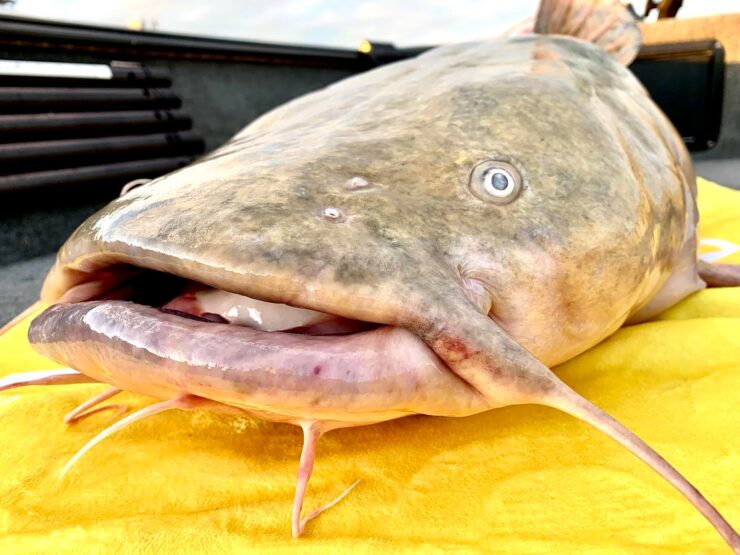
The Flathead Catfish (Pylodictis olivaris) is in a different genus than the Blue and Channel Catfish. They do not have a forked tail, have a much more tapered head, and a more streamlined body. Their coloration varies from a yellowish ochre to olive drab and even almost brown, with mottled dark brown splotches on the sides.
The Flathead’s range is west of the Appalachian mountains from S. Canada to N. Mexico, as far west as Texas. You will seldom find any Flatheads east of the Appalachians.
Although prevalent in lakes, they actually prefer rivers with lots of covers and moderate currents.
They will be near structures and prefer deeper water than the other species. Look for them in holes with plenty of covers.
The Flathead has many nicknames, including Yellow Cat, Mudcat, Appalachian Cat, and Shovelhead. Another U.S. behemoth, can grow to over 5 feet and weigh as much as 100 pounds or more. They live around 23 years, and the average size is around 5-10 pounds. 20 and 30-pounders are common. Unlike the Blue and Channel Cats, Flatheads are almost exclusively live fish eaters.
Smaller individuals can be caught on live crawfish, and juveniles will bite nightcrawlers, but once they get over 1-pound, they concentrate mostly on live fish.
They do not bite commercial dough baits or any other common baits for other species. Live Bluegill (where legal), live shad, and large live minnows are the bait of choice if you want to catch Flatheads.
Another thing about Flatheads is that they have a tendency to be very moody, and sulk at times. You may have to cast several times to a Yellow Cat before it will bite. Patience comes in handy when fishing for Flatheads.
4. Bullhead Catfish
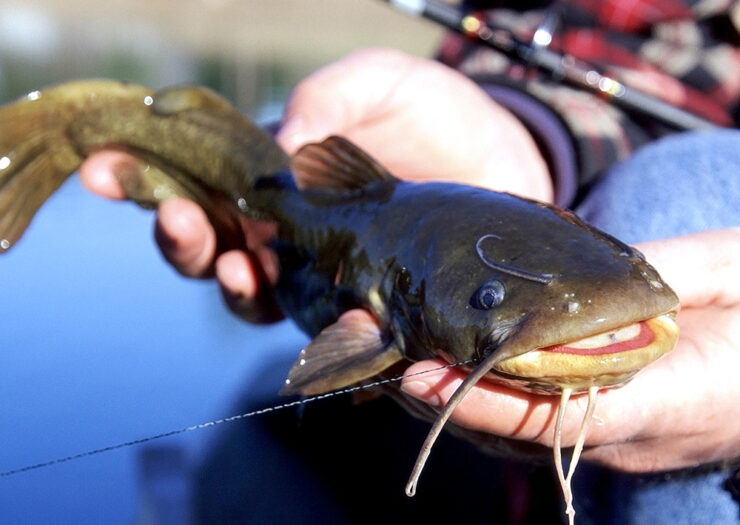
Bullhead Catfish are actually several species of the genus Ameiurus and include the Black, Yellow, Brown, and White Bullheads. The only difference between them is their colors, and where they are found. Bullheads can be found just about anywhere in the U.S. in slow-moving, muddy waters with lower oxygen content. They thrive in turbid waters where nothing else can live other than carp (which can live in just about any freshwater, no matter what the quality).
They differ in appearance from their larger cousins like the Blue and Channel Cats in that they have a flat, non-forked tail.
Their eating habits are the same, only scaled down a bit. They eat just about anything vegetable or meat, dead or alive. They love small crawfish, chicken livers, dough bait, cheese, canned fish, cottonseed cakes, canned corn, and cut bait.
They seldom exceed 2 pounds, although 4 pounders are not unheard of. What they lack in size they make up for as table fare. They are as good as any other catfish to eat, and there are plenty of them, Anyone can catch bullheads when they can find them.
They are a great sport on ultralight gear, or better yet, cane poles and worms.
The only thing I will note here is that if you catch larger individuals when cleaning them, check for any yellow fat around the belly. It can have a little extra fishy taste. Remove the fat, and they will be as good as anything that swims.
Tactics For Catfish
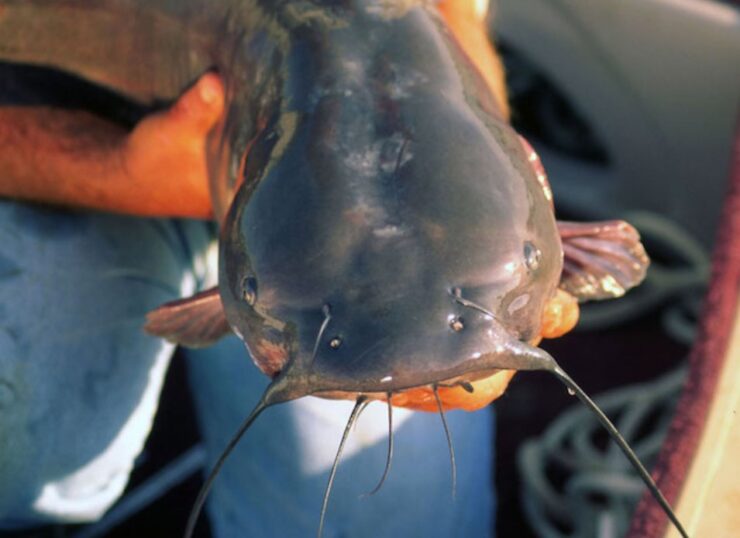
Well… I sort of lied. There are really not many tactics involved. If you find where they are, just toss out a basic rig, and I would be shocked if you didn’t catch some, no matter what bait you use. And locating them is not that hard. Catfish will be near structures in anywhere from 5-20 feet of water. If there is some kind of structure nearby, there will be at least a few catfish there.
And I wouldn’t rule out open water, either.
Sometimes, catfish will find a sinkhole to lay in, or hang out near a drop-off, off the edges of points, at the mouths of coves and inlets, etc…
Below the tailrace behind dams is a prime spot for finding big cats. It’s a little tough fishing due to the fast currents, and you get hung up a lot, but it’s worth it. The best way to fish tailraces is to find eddies near the bank, cast a little upstream from them and let your bait drift into the eddy. Then, hang on tight, because catfish below dams tend to be a bit more aggressive when they bite, rather than play with it some like they do in slower water.
Nighttime is the right time if you really want to catch a lot of catfish.
The best times are from 30 minutes before sundown until around midnight. They tend to ease up a bit after that until around 4:00 AM until 30 minutes after sunrise. The only special gear you might need is a good lantern so you can see your line.
Catfish are active all year long, and in winter, you don’t even have to change the way you fish. The only time they do anything different is in the spring when they spawn. Then they will move into the shallows and find caves and overhanging vegetation to hide in and lay their eggs, sometimes as shallow as 3 feet of water.
hen they move back to their normal hangouts.
In winter, when the water temperature drops below 45⁰F, they may move to a little deeper water, but not far.
As far as bait goes, the very best is native cut bait. Whatever the main forage fish in the area is, that’s what they prefer. Cut shad is outstanding. Beyond this, I have had the best luck with Danny King’s Punch Bait, Magic Bait, Live bluegills, frozen chicken livers, frozen shrimp, and even nightcrawlers.
Other baits may work just as well. I’ve just never gotten around to using them. I have caught catfish on hot dog weiners, chunks of cheddar cheese, and dead minnows. I have heard of people using Moist and Meaty dog food chunks successfully, as well as soap chunks, and other assorted organic baits.
How To Rig For Catfish
As far as equipment goes, you don’t need anything fancy. Any decent rod and reel combo will work well. There are some special Catfish Combos available that are pretty nice, and inexpensive. The rods are nice and stout, and the reels, usually spinning or spin-cast models, have plenty of power if you hook anything extra-belligerent.
Just take care to use a suitable sized rig for the average size catfish you may catch in the area you are fishing.
Don’t try to use a light combo behind a spillway, nor do you need a deep-sea rod behind tailraces. For most situations, a medium action combo is fine, say a Zebco with the outstanding Zebco 33, Omega, or even an 808 reel.
These will be fine for most fish. Of course, you can use baitcasting and spinning reels as well. It’s up to your preferences. Just use a medium-action rod. A heavy action rod may be better for fishing spillways due to the fast current.
Then, all you need is some #1 or 1/0 treble hooks, bait hooks, or Kahle hooks. If you are after trophy fish, or using live sunfish, you may want to step up to a 2/0 hook. Top it off with some ¼ oz, or larger slip sinkers, and a few swivels, and you are in business. You can also use floats if you want. The best rig is a simple slip sinker rig like this:
With this rig, the catfish can pick up the bait without feeling the weight of the sinker. It makes them more likely to go ahead and eat it instead of mouthing it and playing with it.
This rig will also work fine with a cane pole.
If you want to suspend the bait just above the bottom, you can use this same rig and just add afloat, or a slip float.
That’s really all there is to catfishing. Feel free to modify these tips in any way you want. As long as it is legal, there is really no wrong way to fish for catfish if you are catching them. Go out and have some fun….
Happy fishing
Meet Maria Alexander, the fearless adventurer steering the ship at KayakPaddling.net. Her mission? To convince you that life’s too short for dry land and that the best stories always start with “So there I was in my kayak…”

